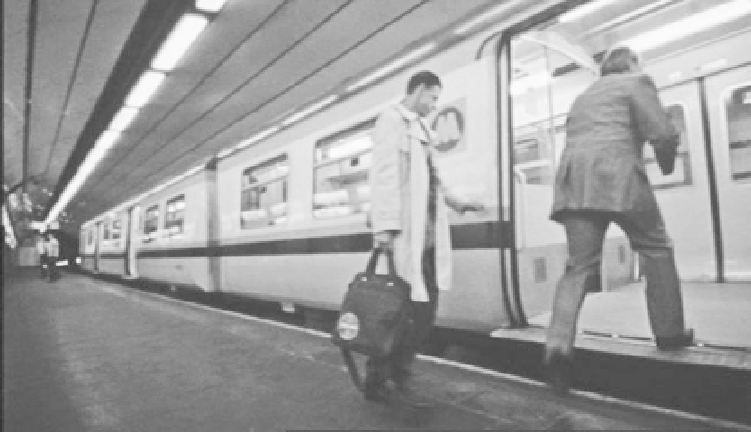Travel Reference
In-Depth Information
structures of cognitive mapping (Cairns, 2006,
p. 199). 'Travelling' the deterritorialized spaces
of Cox's Liverpool, the viewer, like the would-be
consumer and tourist targeted by
Liverpool:
World in One City
, moves seamlessly between
an array of image-spaces, each a virtual brick in
the composite wall of representation that medi-
ates - or obscures - material forms of engage-
ment with the city. Navigating the city in fi lm,
the spectator fi nds his or her embodied urban
analogue in the fi gure of the tourist (or business
traveller) who wanders a landscape composed
of architectural 'jump cuts' and ellipses (Koeck,
2008). This de-localized confi guration of urban
'markers' (MacCannell, 1976, pp. 109-133)
refi nes a post-industrial cityscape that is increas-
ingly unable to articulate its own grounded
(Smith and Katz, 1993) sense of place and
identity. Indeed, '[o]n the ground', as Cairns
suggests, 'this [misalignment of the virtual and
material] generates conditions that mingle
hyperreal zones of spectacle, surveillance, and
control with the left-over, derelict, fallow spaces
of material and economic entropy that are
found in the wake of capital's evacuation from
one place and its concentration in another'
(2006, p. 197). For a clear illustration of this,
we need only consider the relationship between
the phantasmagoric spatialities of the new Liv-
erpool One retail complex and those pockets of
dereliction that are found in the surrounding
inner-urban area.
In
X Films
, Cox recalls comments made by
audience members at an early screening of
Three Businessmen
, noting that many seemed
to genuinely not pick up on the fact that, despite
the very obvious visual clues, Frank and Benny
were travelling between transnational urban
locations (Liverpool, Rotterdam, Hong Kong
and Tokyo) (Figs 17.5 and 17.6):
Consider the scenes with Benny and Frank
aboard the Metro. While we're aboard the train,
it's pretty similar to the Liverpool Merseyrail: a
Metro interior is a Metro interior after all. The
train that Miguel and I board in Liverpool was
painted yellow; the train we emerged in
Rotterdam was green . . . Yet almost no one in
the audience noticed it. This taught me that
people watch fi lms on a shot-by-shot basis.
What they see now, they accept as 'reality'
within the frame, what was on screen fi ve
minutes ago is already forgotten.
(Cox, 2008, p. 242)
Similarly, in an interview with Maximillian Le
Cain, Davies vents her frustration at the way the
fi lm, or rather the fi lm's geographies, are often
(mis)read by audiences (Fig. 17.7):
[I]t's very dispiriting when you have people at
the end of the screening who actually think
there is a Japanese garden that looks like Tokyo
in Liverpool! It gets depressing when people
come up to you and say 'Where is that
Japanese garden in Liverpool?' and you're like
'There were thousands of Japanese people on
Fig. 17.5.
Frank and Benny board the metro at Liverpool . . . (courtesy of Exterminating Angel Films).

Search WWH ::

Custom Search